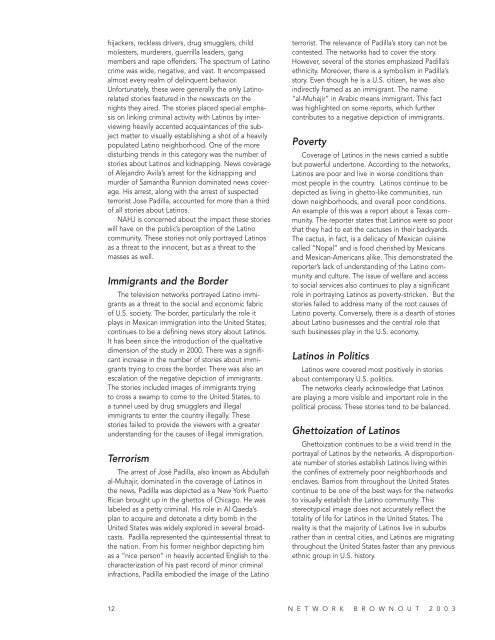You also want an ePaper? Increase the reach of your titles
YUMPU automatically turns print PDFs into web optimized ePapers that Google loves.
hijackers, reckless drivers, drug smugglers, child<br />
molesters, murderers, guerrilla leaders, gang<br />
members and rape offenders. The spectrum of Latino<br />
crime was wide, negative, and vast. It encompassed<br />
almost every realm of delinquent behavior.<br />
Unfortunately, these were generally the only Latinorelated<br />
stories featured in the newscasts on the<br />
nights they aired. The stories placed special emphasis<br />
on linking criminal activity with Latinos by interviewing<br />
heavily accented acquaintances of the subject<br />
matter to visually establishing a shot of a heavily<br />
populated Latino neighborhood. One of the more<br />
disturbing trends in this category was the number of<br />
stories about Latinos and kidnapping. News coverage<br />
of Alejandro Avila’s arrest for the kidnapping and<br />
murder of Samantha Runnion dominated news coverage.<br />
His arrest, along with the arrest of suspected<br />
terrorist Jose Padilla, accounted for more than a third<br />
of all stories about Latinos.<br />
<strong>NAHJ</strong> is concerned about the impact these stories<br />
will have on the public’s perception of the Latino<br />
community. These stories not only portrayed Latinos<br />
as a threat to the innocent, but as a threat to the<br />
masses as well.<br />
Immigrants and the Border<br />
The television networks portrayed Latino immigrants<br />
as a threat to the social and economic fabric<br />
of U.S. society. The border, particularly the role it<br />
plays in Mexican immigration into the United States,<br />
continues to be a defining news story about Latinos.<br />
It has been since the introduction of the qualitative<br />
dimension of the study in 2000. There was a significant<br />
increase in the number of stories about immigrants<br />
trying to cross the border. There was also an<br />
escalation of the negative depiction of immigrants.<br />
The stories included images of immigrants trying<br />
to cross a swamp to come to the United States, to<br />
a tunnel used by drug smugglers and illegal<br />
immigrants to enter the country illegally. These<br />
stories failed to provide the viewers with a greater<br />
understanding for the causes of illegal immigration.<br />
Terrorism<br />
The arrest of José Padilla, also known as Abdullah<br />
al-Muhajir, dominated in the coverage of Latinos in<br />
the news. Padilla was depicted as a New York Puerto<br />
Rican brought up in the ghettos of Chicago. He was<br />
labeled as a petty criminal. His role in Al Qaeda’s<br />
plan to acquire and detonate a dirty bomb in the<br />
United States was widely explored in several broadcasts.<br />
Padilla represented the quintessential threat to<br />
the nation. From his former neighbor depicting him<br />
as a “nice person” in heavily accented English to the<br />
characterization of his past record of minor criminal<br />
infractions, Padilla embodied the image of the Latino<br />
terrorist. The relevance of Padilla’s story can not be<br />
contested. The networks had to cover the story.<br />
However, several of the stories emphasized Padilla’s<br />
ethnicity. Moreover, there is a symbolism in Padilla’s<br />
story. Even though he is a U.S. citizen, he was also<br />
indirectly framed as an immigrant. The name<br />
“al-Muhajir” in Arabic means immigrant. This fact<br />
was highlighted on some reports, which further<br />
contributes to a negative depiction of immigrants.<br />
Poverty<br />
Coverage of Latinos in the news carried a subtle<br />
but powerful undertone. According to the networks,<br />
Latinos are poor and live in worse conditions than<br />
most people in the country. Latinos continue to be<br />
depicted as living in ghetto-like communities, run<br />
down neighborhoods, and overall poor conditions.<br />
An example of this was a report about a Texas community.<br />
The reporter states that Latinos were so poor<br />
that they had to eat the cactuses in their backyards.<br />
The cactus, in fact, is a delicacy of Mexican cuisine<br />
called “Nopal” and is food cherished by Mexicans<br />
and Mexican-Americans alike. This demonstrated the<br />
reporter’s lack of understanding of the Latino community<br />
and culture. The issue of welfare and access<br />
to social services also continues to play a significant<br />
role in portraying Latinos as poverty-stricken. But the<br />
stories failed to address many of the root causes of<br />
Latino poverty. Conversely, there is a dearth of stories<br />
about Latino businesses and the central role that<br />
such businesses play in the U.S. economy.<br />
Latinos in Politics<br />
Latinos were covered most positively in stories<br />
about contemporary U.S. politics.<br />
The networks clearly acknowledge that Latinos<br />
are playing a more visible and important role in the<br />
political process. These stories tend to be balanced.<br />
Ghettoization of Latinos<br />
Ghettoization continues to be a vivid trend in the<br />
portrayal of Latinos by the networks. A disproportionate<br />
number of stories establish Latinos living within<br />
the confines of extremely poor neighborhoods and<br />
enclaves. Barrios from throughout the United States<br />
continue to be one of the best ways for the networks<br />
to visually establish the Latino community. This<br />
stereotypical image does not accurately reflect the<br />
totality of life for Latinos in the United States. The<br />
reality is that the majority of Latinos live in suburbs<br />
rather than in central cities, and Latinos are migrating<br />
throughout the United States faster than any previous<br />
ethnic group in U.S. history.<br />
12 N E T W O R K B R O W N O U T 2 0 0 3



